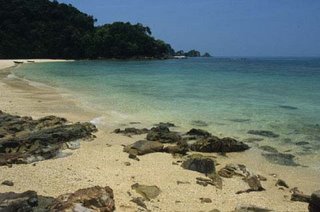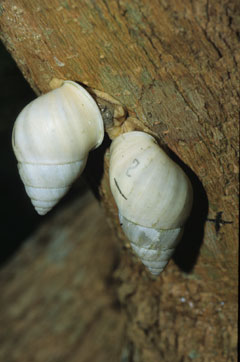 Pulau Kapas in the South China Sea is full of water monitors (Varanus salvator), which scavenge around the bins and pick off the odd rat. It's also absolutely chockers with snails. The trunks and branches of rainforest trees are covered in Amphidromus inversus, a large plain-coloured species of camaenid. It's a bit of an eye opener for Australian snail hunters. Over on this side of the Java Sea, finding native snails takes a major effort.
Pulau Kapas in the South China Sea is full of water monitors (Varanus salvator), which scavenge around the bins and pick off the odd rat. It's also absolutely chockers with snails. The trunks and branches of rainforest trees are covered in Amphidromus inversus, a large plain-coloured species of camaenid. It's a bit of an eye opener for Australian snail hunters. Over on this side of the Java Sea, finding native snails takes a major effort. What's unusual about this species of Amphidromus (apart from their abundance) is they way their shells coil.
What's unusual about this species of Amphidromus (apart from their abundance) is they way their shells coil.Most land snail shells coil to the right. (If you don't believe me, go out into the garden and pick up a snail. Hold it so the shell's apex is pointing away from you and the opening is facing up. On which side does that opening lie? The right! Told you so. But oh no ... you didn't believe me. Had to find out for yourself.) But not Amphidromus inversus. Most of them coil the other way.
Most. But not all. Populations of A. inversus are made up of a mixture of left- and right-handed individuals. (Cue Flanders and Swann.) This mixture of forms is even more peculiar among land snails.
 Dr Menno Schuilthuizen and his colleagues looked at population structure of these snails on Pulau Kapas. The population was stable at 65% sinsistral (left-handed) and 35% dextral. Examining the line up of hypotheses, they discovered that the usual suspects could not explain the anomaly. The feckless snails showed 'a flagrant disregard for population genetics theory'.
Dr Menno Schuilthuizen and his colleagues looked at population structure of these snails on Pulau Kapas. The population was stable at 65% sinsistral (left-handed) and 35% dextral. Examining the line up of hypotheses, they discovered that the usual suspects could not explain the anomaly. The feckless snails showed 'a flagrant disregard for population genetics theory'.Now, you might think that would cause a problem when snails try to mate. But, as you can see from these pictures, it doesn't seem to slow them down. Where's there's a will, there's a snail.
You can read more about Dr Schilthuizen's work at his excellent website.
Read more
Schilthuizen, M., Scott, B.J., Cabanban, A.S. & Craze, P.G. (2005). Population structure and coil dimorphism in a tropical land snail. Heredity 95(3): 216–220